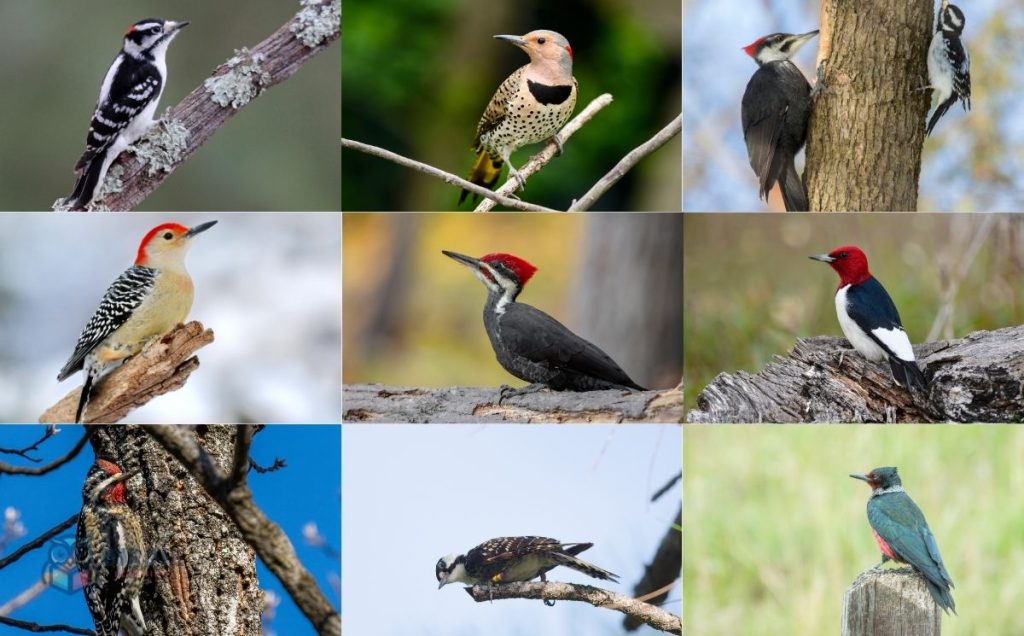
If you are a birder, then the woodpeckers of Virginia will reward you for your patient with their loud drumming and beautiful colors as they quickly fly from tree to tree. You will find many different kinds of woodpeckers in local forests, parks, and suburban settings.
As per National Institute of Health (NIH), Woodpeckers are good indicator species of forest ecosystem dynamics.
Explore the woodpeckers of Virginia with this short guide to your next morning bird outing. Grab your binoculars, and a small notebook to make the most of your outing. If you find a woodpecker of Virginia during an outing or walk, it will be one of your exceptional moments in nature.
Meet the Woodpeckers of Virginia
From tiny drummers to colorful forest giants, these woodpeckers of virginia brings sound, color, and fascinating behaviors to Virginia’s woods and backyards.
1. Downy Woodpecker of virginia

Downy Woodpecker is one of the smallest and most adaptable of the woodpeckers of Virginia. The compact size of downy woodpecker and bold black and white pattern make it easy to spot.
- It is a checkered black and white wings and has the bold white stripe down the back making it recognizable.
- Its tiny stature and straight-backed posture distinguish the Downy woodpecker from other larger woodpeckers of Virginia.
- Listen for a sharp pik and brisk drumming typical of the Downy Woodpecker.
It can be found commonly throughout Virginias backyard spaces all the way through smaller wooded neighborhoods to a park like Shenandoah National Park, and mixed forest patches where it forages throughout smaller branches and trunks. They mostly eat insects like wood boring beetles and will take seeds and suet from the birds. In winter, they sometimes join groups of other birds to find more food. One Downy Woodpecker was observed living for more than 11 years, so now you know how well this small species can thrive.
2. Northern Flicker

The Northern Flicker isThe Northern Flicker Woodpecker is one of the most colorful and vocal of the woodpeckers of Virginia. It is easily identified by its warm brown scalloped feathers and bold spotted belly.
- White rump patch in flight and a tan belly with black spots identify the Northern Flicker Woodpecker.
- Larger and more robinlike in shape compared to many other woodpeckers of Virginia.
- Listen for its loud “wicka wicka” call, it’s hard to miss.
Look for Northern Flicker woodpecker along forest edges, open woods, and parklands where ants are abundant. They are common along the Blue Ridge Parkway and in suburban parks with open ground.
Unlike most woodpeckers, Northern Flicker Woodpecker look for mostly in ground, using a slightly curved bill to dig for ants and beetles. When it flies, you can see yellow or red feathers on its wings, depending on where it lives. You can often see it poking around in the dirt for food. This behavior of searching on the ground is the characteristic of Northern Flicker woodpecker species.
3. Hairy Woodpecker of virginia

The Hairy The Hairy Woodpecker is a larger and stronger cousin to the Downy Woodpecker and it is also a more commonly seen woodpecker of Virginia. With its long chisel like bill and impressive black and white feathers making it look very attractive. Hairy Woodpecker pecks trees and helps control pests.
- Strong black and white head pattern with a long bill are very commonly seen in Hairy Woodpecker.
- Hairy Woodpecker has a noticeably longer bill than the Downy and white outer tail feathers.
- The sound is sharper and louder then downy woodpecker.
The Hairy Woodpecker is found in forests like George Washington and Jefferson National Forests, searching for food and nest in the dead tree trunk.
Hairy Woodpecker excavate deeper into wood to reach beetle larvae and other insects. Its big beak and strong pecking are admired by a lot of lot bird lovers.
4. Red-Bellied Woodpecker

The Red Bellied Woodpecker is a lively and commonly found bird in the woodpeckers of Virginia. It has a bright red head and neck. This bird is smart and easily adapts to different places.
• Red cap and neck with black and white striped back.
• Red Bellied Woodpecker hide nuts in tree bark and later break them open.
• The call sounds like a loud “churr.”
Red Bellied Woodpecker are commonly seen across the mixed woodlands, suburban neighborhoods, and Appalachian forests. They also visit backyards and wooded parks throughout the state. Red Bellied Woodpecker has a long and strong stretchy tongue which they use to remove insects from the hidden places, and also eats fruit and nuts.
5. Pileated Woodpecker

The Pileated Woodpecker is a crow sized giant and one of the most dramatic woodpeckers of Virginia.
- Its red crest and white underwing patches make pileated woodpecker easy to identify.
- The big rectangular holes in dead tree trunks show where it has been feeding.
- Its loud, laughing calls and slow drumming sounds are typical signs of pileated woodpecker presence.
Pileated woodpecker lives in large, dense forests and protected areas like Shenandoah National Park, where there are plenty of dead trees or logs for food and nesting. It mostly eats carpenter ants and beetle larvae, digging deep holes in wood to reach them. These holes later become homes for other animals, making the pileated woodpecker an important helper in the forest ecosystem.
Spotting this pileated woodpecker is a sign of healthy forest filled with other woodpeckers of Virginia and wildlife.
6. Red-Headed Woodpecker

This red headed woodpecker stands out with its bright red head and neck against its contrasting black and white body, this makes it one of the most colorful woodpeckers of Virginia
- You can spot Red Headed woodpecker easily. It has acrobatic flying and sometimes it hangs upside down while searching for food.
- It often calls out with sharp churrs and very loud calls.
- This Red Headed Woodpecker stores seeds and nuts near its nesting area.
You’ll find the Red Headed Woodpecker in open woodlands, orchards, or parks that have old oak or beech trees for nesting. Red headed woodpecker are well known among woodpeckers of Virginia for saving food to eat later.
7. Yellow-Bellied Sapsucker

TThe Yellow bellied Sapsucker is a migratory woodpecker and a common spring and fall visitor among the woodpeckers of Virginia. Some of these peckers even stay through winter in the warmer parts of Virginia.
- Male yellow bellied sapsucker has a red forehead and throat patch, and a long white stripe on the folded wing that helps in identifying them.
- It drills neat rows of small holes called sap wells in trees to drink sap and eat insects that gather there, these are the clear sign that a yellow bellied sapsucker has been there.
You can find yellow bellied sapsucker in mixed hardwood forests and some of the migration paths like Blue Ridge Parkway and Great Dismal Swamp. These holes provide food for other woodpeckers of Virginia. The yellow bellied sapsucker plays an important role in forest ecosystem.
Spotting the distinct red throat and rows of sap holes confirms their presence and highlights yellow bellied sapsucker unique feeding behavior.
8. Red-cockaded Woodpecker

Known for its distinctive white cheek patches and the elusive red cockade found only on males, the Red-cThe Red Cockaded Woodpecker is one of the most specialized and endangered woodpeckers of Virginia. It nests in living pine trees, carving out cavities that also become important homes for other species.
- The white bars on its back form a ladder like pattern, and the white patches on its cheeks helps in identifying Red Cockaded Woodpecker.
- Males have a tiny red spot, or “cockade”, on their cheek, its very rare to spot.
- This Red Cockaded Woodpecker depends on old growth pine forests and careful habitat management to survive.
You can find the Red Cockaded Woodpecker in Piney Grove Preserve and some parts of the Great Dismal Swamp, where forest managers carefully manage longleaf and loblolly pines. Their presence shows that conservationists actively protect mature pine forests.
These Red Cockaded Woodpeckers feed on insects found under pine bark and cooperate in raising their young, with family members helping each other. Their nesting habits and resin-based defense make Red Cockaded Woodpecker truly unique.
As mentioned above Red Cockaded Woodpecker is an endangered species, every nesting group plays a vital role in protecting its population and preserving biodiversity among the woodpeckers of Virginia.
9. Lewis’s Woodpecker

The Lewis’s Woodpecker is rare western visitor and an unusual sight among woodpeckers of Virginia. When it appears, it draws a lot of attention because it behaves more like a flycatcher, often catching insects in midair instead of drilling into trees like most woodpeckers.
- Its shiny green black, pinkish belly and gray collar make Lewis’s woodpecker easy to identify.
- Lewis’s woodpecker feeds mainly on flying insects, but also eats nuts and berries, which it stores in bark cervices for later.
- It is such a rare wanderer, spotting one is a special and exciting event.
You will rarely see Lewis’s Woodpecker in Virginia, as it usually appears in open winds or unexpected places where stray birds travel A confirmed sighting of a Lewis’s Woodpecker is a rare and treasured record, since this species does not normally migrate to the eastern states like other woodpeckers of Virginia.
Discover how hawks see the world read Hawk Vision Explained to learn amazing facts and spotting tips that sharpen your birdwatching skills!
The Magic of the Woodpeckers of Virginia
Woodpeckers of Virginia bring sound, color, and important ecological work to forests and backyards. Their drumming, sap wells, and tree holes tell the story of a healthy woodland, so whether you are a casual walker or an avid birdwatcher, woodpeckers of Virginia rewarding. With a bit of patience and curiosity, you can enjoy unforgettable moments.
For more field guides and tips, check Birdie Learning. Start exploring now.


I don’t think the title of your article matches the content lol. Just kidding, mainly because I had some doubts after reading the article.